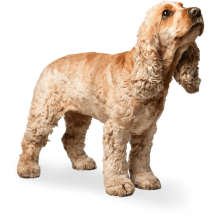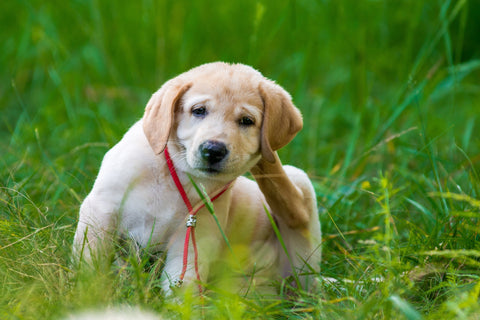

Yeast infections in dogs
Yeasts are everywhere. They make bread rise, ferment drinks and live on your pup’s skin and yours. But sometimes, they grow out of control. Of the 1,500+ species of yeast, one in particular causes problems for dogs: Malassezia pachydermatis. Let’s explore how yeast infections happen, how to spot them and what to do about them.
What are yeast infections in dogs?
Malassezia naturally lives on your pup’s skin, so a yeast infection doesn’t mean they’ve picked up anything contagious. It’s simply an overgrowth, often triggered by underlying issues like allergies, excess moisture or inflammation, which can upset the skin’s natural balance.
Yeasts thrive in warm, damp environments, and Malassezia is a fat-loving yeast perfectly suited to life on a dog. It particularly favours areas rich in oil-producing sebaceous glands – think ears, dog paw infections, lip folds, skin folds, nail beds and spots where skin rubs together, like the armpits and groin.
You’ve probably heard of Candida infections in humans, and while dogs can get them too, they’re rare. Unlike Malassezia, Candida isn’t well-suited to life on a dog and is usually present in very low numbers, if at all. Candidiasis typically occurs after antibiotic or immunosuppressive treatments and affects areas like the mouth lining or gut. Since it’s uncommon, we’ll focus on Malassezia – the more likely culprit.
Just to clarify – all yeasts are fungi, but not all fungal infections are caused by yeasts. For example, ringworm is a fungal infection, but it isn’t yeast related. Other, rarer fungal problems like Aspergillus can affect internal organs, but that’s a different issue entirely.

Signs of yeast infection in dogs
There are two signs that strongly suggest a yeast overgrowth:
- Strong, musty odour
- Dark, greasy or waxy buildup
These signs often appear alongside other symptoms, but the ones below aren’t exclusive to yeast infections:
- Itching skin, licking and head shaking
- Red inflamed skin
- Flaky, dry or greasy skin
- Thickened or darkened skin, often described as elephant-like
- Crusty and/or hairless patches, especially in skin folds or around the lips
Pictures of yeast infection in dogs’ ears (and elsewhere)
You can’t diagnose a yeast infection based on appearance alone. Why? Because yeast overgrowth often happens for a reason – and it can turn up alongside bacterial overgrowth or inflammation. What looks like yeast could actually be a mixed infection, or something else entirely. Swabs or samples are usually needed to confirm the cause and guide treatment.
Still, here are a few visual clues that could point to a yeast problem:

This dog has a generalised concern, but the ear is thickened, with darkened skin and thick, waxy discharge – changes that could point to possible yeast overgrowth.
This little dog has very inflamed, dry skin with dark patches and thickening. While there may be an underlying condition, this type of skin can be prone to yeast overgrowth.
How do dogs get yeast infections
Malassezia is a type of yeast that’s normally present on your dog’s skin. It tends to cause problems only when the natural balance is disrupted, creating an opportunity for it to overgrow. Common triggers can include:
- Skin injuries or damage
- Moisture buildup in ears, paws, folds or nail beds
- Allergies (environmental or food-related)
- Medication (especially antibiotics or steroids)
- Immune system issues or long-term inflammation
How to treat dogs with yeast infections
Effective management involves more than targeting the yeast itself – it’s about helping restore balance and addressing the factors that may have contributed to the overgrowth.
Identify and treat the underlying cause
This may involve:
- Skin swabs or scrapes
- Blood tests
- Allergy investigation
Keep the area clean and dry
- Ears: Use a vet-approved ear cleaner only after your vet confirms the eardrum is intact - read our guide on how to clean your dog's ears
- Paws: Medicated shampoos or paw soaks
- Skin folds: Medicated wipes are especially handy here
Use the right medication
- Topical antifungals: Ear drops, antifungal creams, gels, nail bed treatments or shampoos can clear surface infections
- Oral medication: Reserved for severe, widespread or recurrent cases
- Anti-itch or anti-inflammatory medications: Help stop scratching and inflammation, allowing for healing
- Additional meds: If bacteria or another illness is involved, other treatments may be added
Support long-term skin health
If your pup has areas of concern, regular at-home checks plus gentle cleaning and thorough drying can be helpful. Providing a high-quality diet and skin-supporting supplements may also help maintain healthy skin and its natural defences. Malassezia typically lives on the skin’s surface – so unless your dog has a rare Candida-type infection, low-carb diets are not usually needed for managing yeast balance.
Dog yeast infection home remedy
You may have heard of vinegar rinses to help with yeast concerns. And yes, slightly acidic solutions can make the skin less welcoming to yeast. But even diluted vinegar can sting sore, inflamed skin, and it won’t address the underlying cause. That’s why it’s best to involve your vet. Home remedies may have a place, but only as part of a plan that considers both the yeast and what’s driving the overgrowth.
Yeast issues can be greasy and smelly, signalling that the skin’s balance may be off. The right approach can help support your pup’s skin back to a healthier state – so if something smells unusual, a vet check is worthwhile. Healthy skin makes for a happier, tail-wagging dog.




